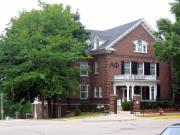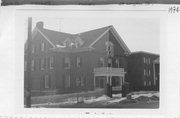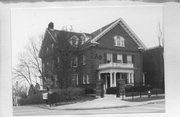Property Record
28 LANGDON ST
Architecture and History Inventory
| Historic Name: | Frank G. and Mary G. Brown House |
|---|---|
| Other Name: | Alpha Phi Sorority House |
| Contributing: | Yes |
| Reference Number: | 101629 |
| Location (Address): | 28 LANGDON ST |
|---|---|
| County: | Dane |
| City: | Madison |
| Township/Village: | |
| Unincorporated Community: | |
| Town: | |
| Range: | |
| Direction: | |
| Section: | |
| Quarter Section: | |
| Quarter/Quarter Section: |
| Year Built: | 1905 |
|---|---|
| Additions: | 1927 |
| Survey Date: | 1985 |
| Historic Use: | house |
| Architectural Style: | Colonial Revival/Georgian Revival |
| Structural System: | |
| Wall Material: | Brick |
| Architect: | Law, Law and Potter |
| Other Buildings On Site: | |
| Demolished?: | No |
| Demolished Date: |
| National/State Register Listing Name: | Langdon Street Historic District |
|---|---|
| National Register Listing Date: | 6/26/1986 |
| State Register Listing Date: | 1/1/1989 |
| National Register Multiple Property Name: |
| Additional Information: | Madison Historic Landmark: 4/25/1983 "The history of this house illustrates the transition of many large homes in the district from single-family residences to student housing. Frank G. Brown was a businessman and financier in 1905. he managed his father's extensive real estate and lending concerns and helped found the French Battery Company, now Ray-O-Vac, one of Madison's most successful industries. In 1920, Frank Brown died, and his wife continued to live in the house until 1927. In that year, Alpha Phi sorority moved into the house and have occupied it ever since. This house is an early version of the colonial revival style. Its main features are an unusual front intersecting gable roofline, a cornice with dentils, and returned eaves. The gracious entry porch is decorated with round columns and Roman Ionic capitals and a cornice topped by a balustrade. At the rear of the house is a large porch overlooking the back lot which slopes down to Lake Mendota. At the foot of N. Carroll Street behind this house is the site of the old municipal boathouse. Frank Lloyd Wright, then an unknown architect in Chicago, designed the boathouse in 1893. Wright's design was the winner of a competition sponsored by the Madison Improvement Association. The twin-towered boathouse was Wright's first design in Madison an was, unfortunately, torn down in 1928." City of Madison, The Langdon Street Historic District: A Walking Tour, 1986. Research from 2021: The architects are listed as Law, Law & Potter which implies they were responsible for the original design in 1905. The firm did not yet exist at that time. James Law established his practice in 1913 and his brother Edward joined him in 1917 and the firm became known as Law & Law. The firm was renamed Law, Law & Potter when Ellis Potter became a full partner in 1925. It's possible that Law, Law & Potter did alterations in 1927, though the project is not listed among the firm's work in the Madison Intensive Survey: Master Architects document compiled in 2006 by Katherine Rankin and Timothy Heggland. In 1927 Alphi Phi Sorority was issued a building permit for $2,800 for interior alterations (Wisconsin State Journal, 23 Dec 1927). No architect is listed, though there may be something in the city's files. Madison's landmark nomination which dates from 1983, credits no architect for the Frank & Mary Brown House. |
|---|---|
| Bibliographic References: | City of Madison, The Langdon Street Historic District: A Walking Tour, 1986. |
| Wisconsin Architecture and History Inventory, State Historic Preservation Office, Wisconsin Historical Society, Madison, Wisconsin |




